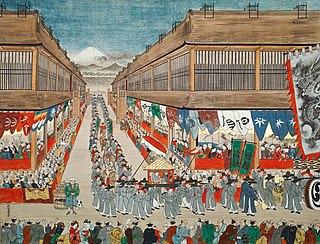Related Research Articles

The Ashikaga shogunate, also known as the Muromachi shogunate, was the feudal military government of Japan during the Muromachi period from 1336 to 1573.

The Japanese missions to Imperial China were diplomatic embassies which were intermittently sent to the Chinese imperial court. Any distinction amongst diplomatic envoys sent from the Japanese court or from any of the Japanese shogunates was lost or rendered moot when the ambassador was received in the Chinese capital.

Ashikaga Yoshimochi was the fourth shōgun of the Ashikaga shogunate who reigned from 1394 to 1423 during the Muromachi period of Japan. Yoshimochi was the son of the third shōgun, Ashikaga Yoshimitsu, and the elder brother of the sixth third shōgun, Ashikaga Yoshinori.

Ōei (応永) was a Japanese era name after Meitoku and before Shōchō. This period spanned the years from July 1394 through April 1428. Reigning emperors were Go-Komatsu-tennō (後小松天皇,) and Shōkō-tennō (称光天皇).

The Joseon Tongsinsa (Korean: 조선통신사) were goodwill missions sent intermittently, at the request of the resident Japanese authority, by Joseon dynasty Korea to Japan. The Korean noun identifies a specific type of diplomatic delegation and its chief envoys. From the Joseon diplomatic perspective, the formal description of a mission as a tongsinsa signified that relations were largely "normalized," as opposed to missions that were not called tongsinsa.
Yun Sunji was a scholar-official of the Joseon Dynasty Korea in the 17th century.
Im Gwang was a scholar-official of the Joseon Dynasty Korea.
Byeon Hyo-mun (1396–?) was a Korean civil minister (munsin) from the Chogye Byeon clan during the early period of Korean Joseon Dynasty. He briefly served as a diplomat and an ambassador, representing Joseon interests in the Tongsinsa to the Ashikaga shogunate in Japan.
Song Hui-gyeong was a Korean scholar-official of the Joseon period in the 15th century.
Pak Ton-ji was a Korean scholar-bureaucrat, diplomat, and ambassador, representing Joseon interests in the tongsinsa to the Ashikaga shogunate in Japan. He lived from the late Goryeo until the early Joseon periods.
Go Deuk-jong was a scholar-official of the Joseon Dynasty Korea in the 14th century.
Yang Su was a Korean diplomat and ambassador, representing Joseon interests in a diplomatic mission to the Ashikaga shogunate in Japan.

Joseon missions to Japan represent a crucial aspect of the international relations of mutual Joseon-Japanese contacts and communication. In sum, these serial diplomatic ventures illustrate the persistence of Joseon's kyorin diplomacy from 1392 to 1910.
Pak Hŭi-chung was a scholar-official of the Joseon Dynasty Korea in 14th and 15th centuries.
Yun Myeong (?–?) was a scholar-official of the Joseon Dynasty Korea in the 15th century.
Yŏ Ŭi-son was a Korean civil minister (munsin) and diplomat from the Hamyang Yŏ clan during the early period of the Joseon dynasty. Yŏ served as the first governor (moksa) of the Jeju Island and a Jeonseo (minister). He also was sent to Japan as a diplomat representing Joseon.
Pak An-sin was a scholar-official of the Joseon Dynasty Korea in the 15th century.
The Korean Joseon dynasty (1392–1897) sent numerous diplomatic missions to the Chinese Ming (1368–1644) and Qing (1644–1912) dynasties.
Joseon diplomacy was the foreign policy of the Joseon dynasty of Korea from 1392 through 1910; and its theoretical and functional foundations were rooted in Neo-Confucian scholar-bureaucrats, institutions and philosophy.
Goryeo missions to Japan represent a crucial aspect of the international relations of mutual Goryeo-Japanese contacts and communication, especially during the years in which there were no official contacts between the leaders of Goryeo and the leaders of Japan.
References
- Ferris, William Wayne. (2009). Japan to 1600: a Social and Economic History. Honolulu: University of Hawaii Press. ISBN 978-0-824-83379-4
- Hall, John Whitney. (1997). The Cambridge History of Japan: Early Modern Japan. Cambridge: Cambridge University Press. ISBN 978-0-521-22355-3; OCLC 174552485
- (in Korean) 한일관계사연구논집편찬위원회. (2005). 통신사・왜관과한일관계 (Han Il kwangyesa yŏngu nonjip, Vol. 6). 경인문화사. ISBN 978-8-949-90308-8.
- Kang, Etsuko Hae-jin. (1997). Diplomacy and Ideology in Japanese-Korean Relations: from the Fifteenth to the Eighteenth Century. Basingstoke, Hampshire; Macmillan. ISBN 978-0-312-17370-8; OCLC 243874305
- Kang, Woong Joe. (2005). The Korean Struggle for International Identity in the Foreground of the Shufeldt Negotiation, 1866-1882. Latham, Maryland: University Press of America. ISBN 978-0-761-83120-4; OCLC 238760185
- Titsingh, Isaac, ed. (1834). [Siyun-sai Rin-siyo/Hayashi Gahō, 1652], Nipon o daï itsi ran; ou, Annales des empereurs du Japon. Paris: Oriental Translation Fund of Great Britain and Ireland. OCLC 84067437
- Toby, Ronald P. (1991). State and Diplomacy in Early Modern Japan: Asia in the Development of the Tokugawa Bakufu. Stanford: Stanford University Press. ISBN 978-0-804-71951-3; OCLC 25473164
- Walker, Brett L. "Foreign Affairs and Frontiers in Early Modern Japan: A Historiographical Essay," Early Modern Japan. Fall, 2002, pp. 44–62, 124-128.
